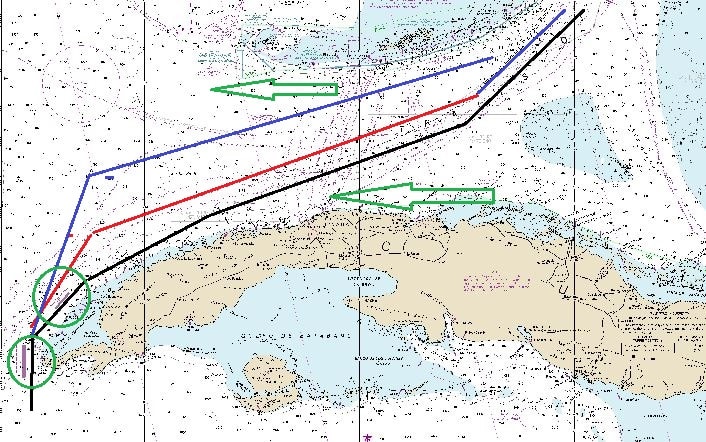Today we finally had a day, the way most of us remember the Caribbean from the 1980’s. Wind force 4 (16 knots) and not more, sun all around with only a few wisps of clouds in the air and a nice blue sea with a low swell. That is the way it should always be outside the hurricane season but now those days are few and far in between; it seems to be so much windier than before. But we will embrace every gift from Mother Nature with gratefulness. So a gorgeous day it was.
This morning at 09.30 we entered the Vessel Traffic Separation (VTS) system of Cabo San Antonia, the west point of Cuba and from there we hugged the Cuban coast until well into the Straits of Florida. Then we worked our way slowly more into the middle, to see if we can find the Gulf Stream later in the day. The Gulf Stream moves from North to South in the Straits of Florida and nobody has yet been able to predict exactly when it moves or why it is doing that. Sometimes it is closer to Florida and sometimes it is closer to Cuba. Important for us to know, as when for some reason the current is closer to Florida, then the counter current along the North coast of Cuba is stronger. We need to know that otherwise we keep “hugging” the coast too long and instead of gaining speed we will lose speed and thus time.
Chartlet explanation:
The two green circles indicate the two VTS systems off the west coast of Cuba. The two green arrows indicate the two counter currents in the Straits of Florida. How strong, depends on the location of the axis of the Gulf Stream.
The black line is the most direct course to Fort Lauderdale but we only get the benefit of the Gulf Stream very late in the day.
The red line in many variations is the course the ship follows to try and find the happy medium between the shortest distance and the best current.
The blue one would be the easiest way to find where exactly the Gulf Stream is located but it adds a larger number of miles to the voyage and it would be by no means certain if those extra miles would be fully compensated by the extra current gained.
The normal shipboard routine is then as follows. We nicely follow the VTS along the Cuban coast near Cabo San Antonio and then go with the curve of the Cuban coast to the North East. There is another VTS located which ensures that deep sea and coastal shipping do not get into muddle with each other. We do not have to follow the VTS, we can keep completely clear of it but when we are following a similar route that we have to use it and comply with the rules. Then the ships speed log is carefully observed to see if the speed dips or picks up. The navigation team has to find the balance between trying to find the strongest current without losing to many miles in distance while doing so. Miles that will then not be compensated by the increase in current gained.
If we do it right, then from noon time today until tomorrow morning 05.00 we can gain at least 2 miles each hour and that would be 17 hours and thus 34 miles, which is more than 1.5 hrs. of sailing at full speed. As we burn on average 0.32 tons of fuel for each mile travelled at full speed that is 10.88 tons at a minimum which saves us at least 4000 US dollars in fuel cost. In reality it is even more, as the more we gain in miles, the less average speed we have to maintain, the more we can reduce speed and switch off engines and the more fuel we save. This is big business so to say and it takes up the full focus of the navigation team.
We Dutch are very good at navigating here, a lot of Dutch explorers and pirates have been messing around here, including Piet Hein a famous Dutch Sea Admiral who captured a Spanish Silver Fleet in this area and the profit helped the Dutch Government out of their national debt. Piet Hein got very famous in Cuba as well; the Cubans did not like the Spanish very much and there is still a statue of him outside Havana. More about that in the future, as I will join the Veendam on Feb. 28th. so I am going there.
Tomorrow we are in Ft. Lauderdale as it is the end of our 11 day cruise. It will be a busy day with 7 cruise ships in and the harbor master wants us early. Around 5 am in the morning, this is not exactly what we on board had in mind. We are expecting the Carnival Conquest, the Celebrity Summit, the Koningsdam, the Freedom of the Seas and the Harmony of the Seas, plus the local cruise ferry to Nassau. Most of them are very big boys and Fort Lauderdale is currently one dock short as they are rebuilding 25/24 and the plan for us is to dock now in the middle and thus they want us early. Weather looks nice 27oC / 80oF with partly cloudy skies and a light breeze. It is going to be a warm ending of the cruise.


Leave a Reply